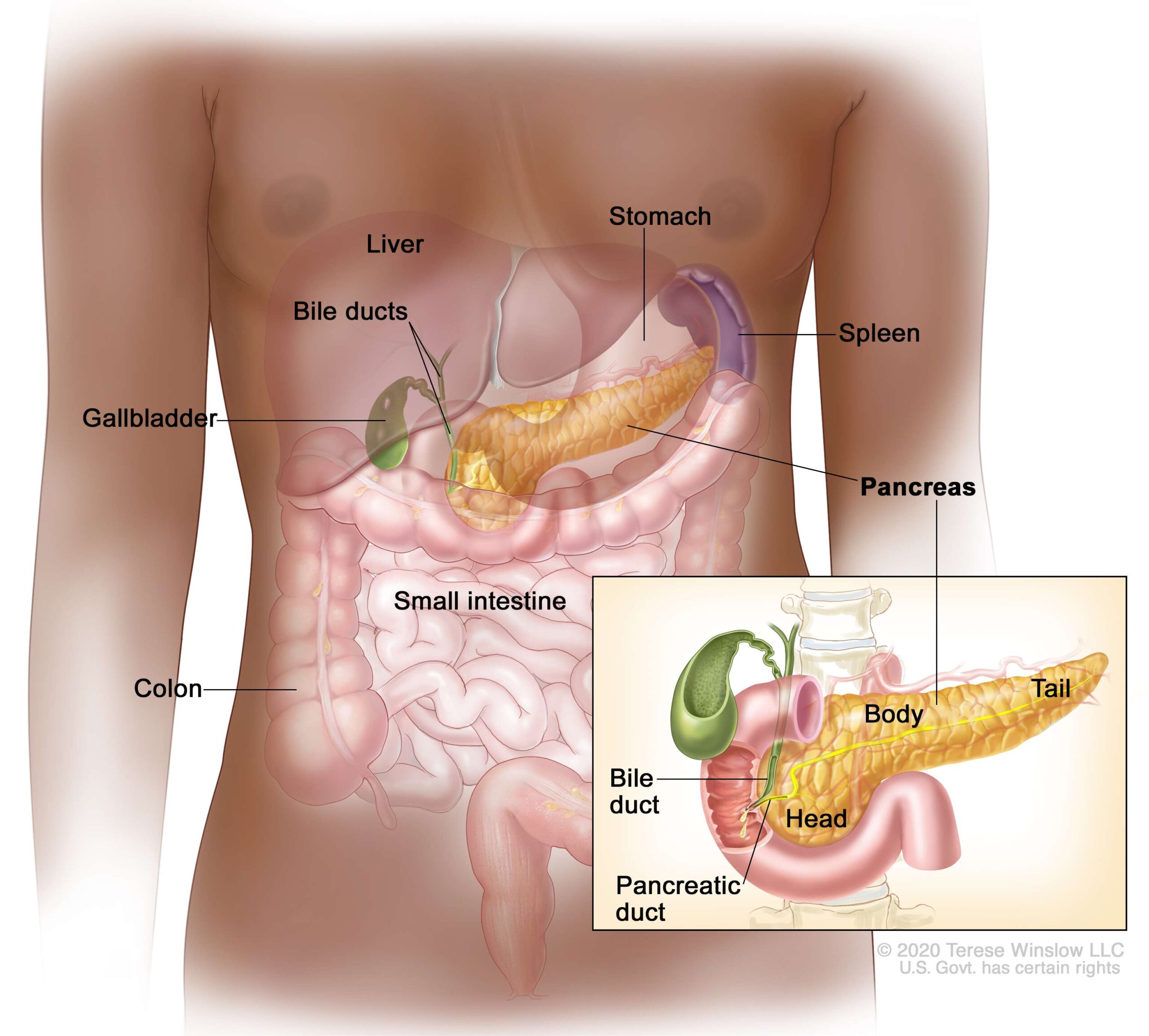 The pancreas is a gland, about six inches long, located in the abdomen. It is shaped like a flat pear and is surrounded by the stomach, small intestine, liver, spleen and gallbladder. The wide end of the pancreas on the right side of the body is called the head. The middle sections are the neck and body. The thin end of the pancreas on the left side of the body is called the tail. The uncinate process is the part of the gland that bends backwards and underneath the head of the pancreas. Three major blood vessels cross behind the pancreas: the superior mesenteric artery, the superior mesenteric vein, and the portal vein. The pancreas is both an exocrine gland and endocrine gland and has two main functions – digestion and blood sugar regulation.
The pancreas is a gland, about six inches long, located in the abdomen. It is shaped like a flat pear and is surrounded by the stomach, small intestine, liver, spleen and gallbladder. The wide end of the pancreas on the right side of the body is called the head. The middle sections are the neck and body. The thin end of the pancreas on the left side of the body is called the tail. The uncinate process is the part of the gland that bends backwards and underneath the head of the pancreas. Three major blood vessels cross behind the pancreas: the superior mesenteric artery, the superior mesenteric vein, and the portal vein. The pancreas is both an exocrine gland and endocrine gland and has two main functions – digestion and blood sugar regulation.
The Pancreas and Digestion
Exocrine cells of the pancreas produce enzymes that help with digestion. When food enters the stomach, exocrine cells release the pancreatic enzymes into a system of small ducts that lead to the main pancreatic duct. The pancreatic duct runs the length of the pancreas and carries pancreatic enzymes and other secretions, collectively called pancreatic juice.
The main pancreatic duct connects with the common bile duct, which carries bile from the gallbladder, and together they connect with the duodenum at a point called the ampulla of Vater. Here, bile and pancreatic enzymes enter the duodenum to aid with the digestion of fats, carbohydrates and proteins.
Blood Sugar Regulation
The endocrine cells of the pancreas produce hormones. Hormones are substances that control or regulate specific functions in the body. They are usually made in one part of the body and carried through the blood to take action on another part of the body. The two main pancreatic hormones are insulin and glucagon. Islet cells are endocrine cells within the pancreas that produce and secrete insulin and glucagon into the bloodstream. Insulin lowers blood sugar levels while glucagon raises blood sugar levels. Together, these two main hormones work to maintain the proper level of sugar in the blood.
Learn About Pancreatic Cancer
Pancreatic cancer begins when abnormal cells in the pancreas grow out of control and form a tumor. The symptoms associated with pancreatic cancer are often vague, similar to symptoms caused by other conditions and may not be present in early stages of the disease. Learn about pancreatic cancer symptoms, types of pancreatic cancer, diagnosis, treatments and more.
We’re Here to Help
For free, in-depth and personalized resources and information on pancreatic cancer, contact PanCAN Patient Services.
Information reviewed by PanCAN’s Scientific and Medical Advisory Board, who are experts in the field from such institutions as University of Pennsylvania, Memorial Sloan-Kettering Cancer Center, Virginia Mason Medical Center and more.
Information provided by the Pancreatic Cancer Action Network, Inc. (“PanCAN”) is not a substitute for medical advice, diagnosis, treatment or other health care services. PanCAN may provide information to you about physicians, products, services, clinical trials or treatments related to pancreatic cancer, but PanCAN does not recommend nor endorse any particular health care resource. In addition, please note any personal information you provide to PanCAN’s staff during telephone and/or email communications may be stored and used to help PanCAN achieve its mission of assisting patients with, and finding cures and treatments for, pancreatic cancer. Stored constituent information may be used to inform PanCAN programs and activities. Information also may be provided in aggregate or limited formats to third parties to guide future pancreatic cancer research and education efforts. PanCAN will not provide personal directly identifying information (such as your name or contact information) to such third parties without your prior written consent unless required or permitted by law to do so. For more information on how we may use your information, you can find our privacy policy on our website at https://www.pancan.org/privacy/.





